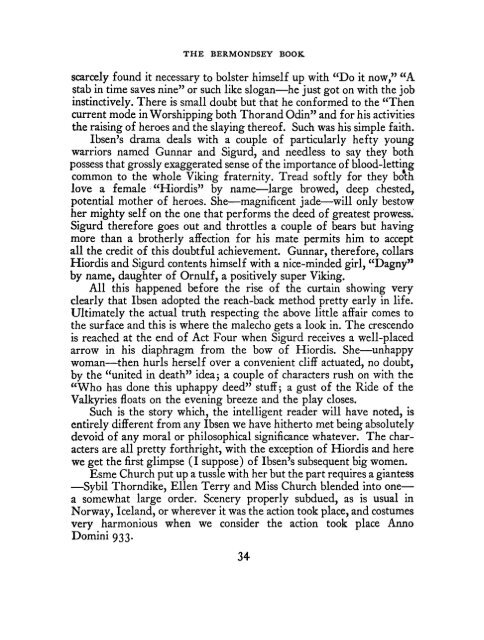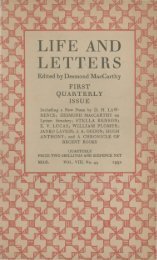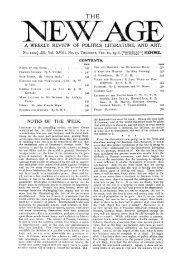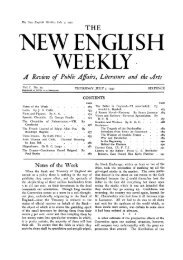Vol. VI No. 1 - Modernist Magazines Project
Vol. VI No. 1 - Modernist Magazines Project
Vol. VI No. 1 - Modernist Magazines Project
You also want an ePaper? Increase the reach of your titles
YUMPU automatically turns print PDFs into web optimized ePapers that Google loves.
THE BERMONDSEY BOOK<br />
scarcely found it necessary to bolster himself up with "Do it now," "A<br />
Stab in time saves nine" or such like slogan—he just got on with the job<br />
instinctively. There is small doubt but that he conformed to the "Then<br />
current mode in Worshipping both Thorand Odin" and for his activities<br />
the raising of heroes and the slaying thereof. Such was his simple faith.<br />
Ibsen's drama deals with a couple of particularly hefty young<br />
warriors named Gunnar and Sigurd, and needless to say they both<br />
possess that grossly exaggerated sense of the importance of blood-letting<br />
common to the whole Viking fraternity. Tread softly for they bo*th<br />
love a female "Hiordis" by name—large browed, deep chested,<br />
potential mother of heroes. She—magnificent jade—will only bestow<br />
her mighty self on the one that performs the deed of greatest prowess.<br />
Sigurd therefore goes out and throttles a couple of bears but having<br />
more than a brotherly affection for his mate permits him to accept<br />
all the credit of this doubtful achievement. Gunnar, therefore, collars<br />
Hiordis and Sigurd contents himself with a nice-minded girl, "Dagny"<br />
by name, daughter of Ornulf, a positively super Viking.<br />
All this happened before the rise of the curtain showing very<br />
clearly that Ibsen adopted the reach-back method pretty early in life.<br />
Ultimately the actual truth respecting the above little affair comes to<br />
the surface and this is where the malecho gets a look in. The crescendo<br />
is reached at the end of Act Four when Sigurd receives a well-placed<br />
arrow in his diaphragm from the bow of Hiordis. She—unhappy<br />
woman—then hurls herself over a convenient cliff actuated, no doubt,<br />
by the "united in death" idea; a couple of characters rush on with the<br />
"Who has done this uphappy deed" stuff; a gust of the Ride of the<br />
Valkyries floats on the evening breeze and the play closes.<br />
Such is the story which, the intelligent reader will have noted, is<br />
entirely different from any Ibsen we have hitherto met being absolutely<br />
devoid of any moral or philosophical significance whatever. The characters<br />
are all pretty forthright, with the exception of Hiordis and here<br />
we get the first glimpse (I suppose) of Ibsen's subsequent big women.<br />
Esme Church put up a tussle with her but the part requires a giantess<br />
—Sybil Thorndike, Ellen Terry and Miss Church blended into one—<br />
a somewhat large order. Scenery properly subdued, as is usual in<br />
<strong>No</strong>rway, Iceland, or wherever it was the action took place, and costumes<br />
very harmonious when we consider the action took place Anno<br />
Domini 933.<br />
34












